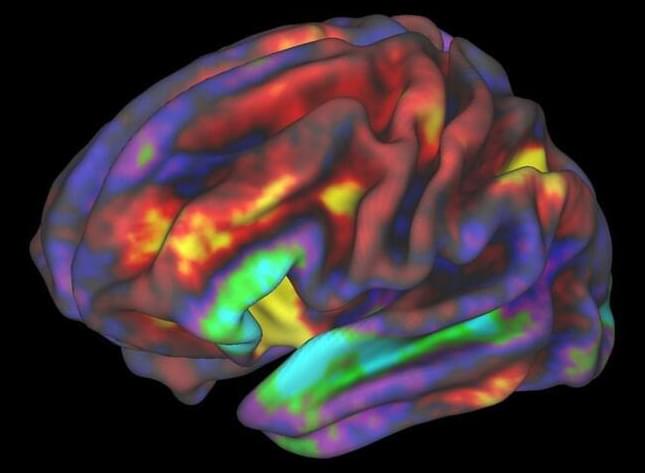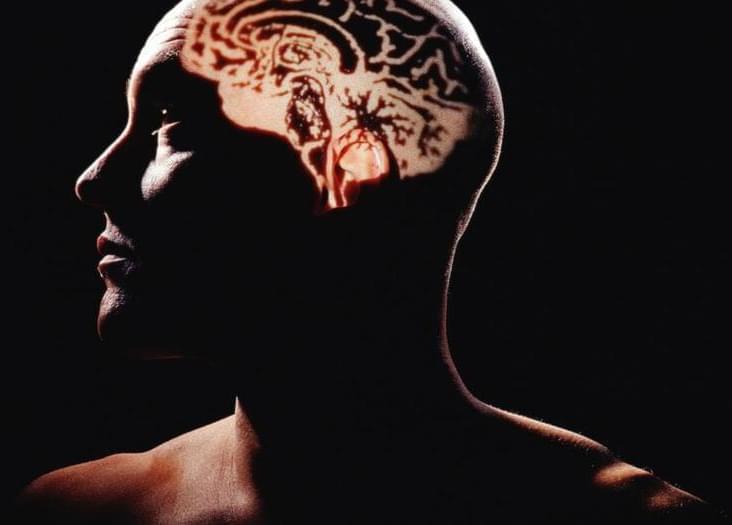The most powerful way to combat anxiety is to consistently work on building your resilience and mental strength. “Along the way, you’ll learn to appreciate or even welcome certain kinds of mistakes for all the new information they bring you,” says neuroscientist Wendi Suzuki.
Category: neuroscience – Page 857

Mapping the Brain Circuitry of Spirituality
Summary: Researchers find a region of the brain stem called the periaqueductal gray may mediate religiosity and spirituality in humans.
Source: Elsevier.
Scientists have long suspected that religiosity and spirituality could be mapped to specific brain circuits, but the location of those circuits remains unknown. Now, a new study using novel technology and the human connectome, a map of neural connections, has identified a brain circuit that seems to mediate that aspect of our personality.

A Neuroscience Theory That Actually Helps Explain the Brain
I believe the transduction theory has a great deal to offer in our scientific study of the mind–brain relationship. It is, of course, a dualist theory. It provides a framework for understanding the close link between brain states and mental states, yet at the same time, it explains mental states in a way that does not invoke nonsensical materialist metaphysics.
A successful understanding of the mind–brain relationship will necessarily involve understanding the brain as a transduction device in one way or another. Such an understanding could prove enormously fruitful and can help us move beyond the current materialist framework in which neuroscience is practiced, which has has held us so far back in our understanding of the mind and the brain. The brain is obviously material but it is just as obvious that the mind has immaterial abilities.
We accept that the ear is a transducer for sound to hearing and the eye is a transducer for light to vision. It is reasonable to infer that the brain is a transducer for thought to body. Transduction theory is a plausible approach to understanding the connection between the mind and the brain. It should be taken seriously by neuroscientists and philosophers of the mind.
Scientists discover quantum mechanical switching in ferritin structures similar to those found in neural tissue
Quantum mechanics generally refers to the wave-like properties of things that are commonly considered to be particles, such as electrons. This article discusses evidence of a quantum mechanical switching function that is performed by strictly biological structures—ferritin protein layers that are found in cells including neural tissue.
Many scientists are investigating quantum biology, which is the application of quantum mechanics to investigate biological functions. It has recently been used to answer a number of previously unanswered questions, such as the mechanisms behind photosynthesis and the way birds can perceive magnetic fields. These quantum biological effects generally involve electrons hopping or tunneling over distances of several nanometers, behavior that is incompatible with particles but which makes sense with waves.
Ferritin is a spherical iron storage protein that is found in plants and animals. Early studies of ferritin to look for quantum mechanical effects were conducted at cryogenic temperatures, because it was thought that biological structures were too “warm and wet” to exhibit such effects. Those studies were somewhat inconclusive. But when ferritin was subsequently electrically tested at room temperature, it was discovered that electron tunneling was occurring.

Study shows that rewarded life experiences are replayed and consolidated during sleep
Past neuroscience studies have consistently showed that sleep plays an important role in memory consolidation. For instance, some neuroimaging research showed that the brain regions that are activated while humans are encoding waking experiences can later be reactivated during sleep, particularly during non-rapid eye movement (NREM) sleep.
Interestingly, the same brain regions are also associated with increased local slow-wave activity (SWA). Interestingly, the activation of these brain regions and SWA are known to be associated with two mechanisms related to memory optimization, namely neural replay and synaptic homeostasis. These mechanisms are typically associated with improvements in behavior over time.
Researchers at University of Geneva in Switzerland have recently carried out a study aimed at investigating the ways in which the brain selects memories that will be reprocessed during sleep. Their findings, presented in a paper published in Nature Communications, suggest that the brain tends to prioritize the consolidation of memories or life experiences with high motivational relevance, namely those associated with rewards.

Cholesterol Flags Violence Risk in People With Schizophrenia
Summary: Lower cholesterol levels may put people with schizophrenia at higher risk for violent behaviors, including self-harm and suicide. Researchers say lower cholesterol levels make brain cells less sensitive to serotonin, increasing symptoms of depression, impulsivity, and aggression.
Source: Brunel University.
Linked to lower risk of heart attacks and strokes, low cholesterol may also be a sign people with schizophrenia are at high risk of self-harm, suicide and violence.

Early-life sleep disruptions linked to irregular development of the prefrontal cortex
The mechanism by which sleep disruption impedes neurodevelopment, however, is still not well understood. It may be that increased wakefulness due to sleep disruption increases glutamate circulation in the brain, affecting glutamatergic structures. Alternatively, decreased REM sleep may reduce “pruning”, an essential developmental process in which superfluous synapses are removed to improve signaling and organization.
The period of neurodevelopment extending from birth to roughly two years of age is one of frenetic, constant change. Neurons and synapses form, are organized, and are pruned. It is well known that sleep plays a fundamental role in these processes, and disruptions to sleep at this stage can be devastating to neurodevelopment and may be the cause of disorders like autism spectrum disorder (ASD).
Understanding the relation between sleep and neurodevelopment in early life is thus essential to understanding (and perhaps preventing) developmental disorders. Building on previous work with prairie voles—a highly social animal with neurodevelopmental similarities to humans—researchers from Portland and California recently published a paper in Current Research in Neurobiology examining the effects of early life sleep disruptions (ELSD) on the prefrontal cortex (PFC).
The prefrontal cortex plays an important role in higher-order social learning, executive function, and cognitive flexibility. It’s also one of the last brain structures to mature, and is thus particularly sensitive to disruptions in development.
The Science Behind NMN —A Stable, Reliable NAD+Activator and Anti-Aging Molecule
Nad plus works for alzheimers.
In June of 2,018 the World Health Organization (WHO) released the 11th edition of its International Classification of Diseases, and for the first time added aging.1 The classification of aging as a disease paves the way for new research into novel therapeutics to delay or reverse age-related illnesses such as cancer, cardiovascular and metabolic disease, and neurodegeneration.2,3 Nutrient sensing systems have been an intense focus of investigation, including mTOR (the mammalian target of rapamycin) for regulating protein synthesis and cell growth; AMPK (activated protein kinase) for sensing low energy states; and sirtuins, a family of seven proteins critical to DNA expression and aging, which can only function in conjunction with NAD+ (nicotinamide adenine dinucleotide), a coenzyme present in all living cells.4
Across the kingdom of life, an increase in intracellular levels of NAD+ triggers shifts that enhance survival, including boosting energy production and upregulating cellular repair.5 In fact, the slow, ineluctable process of aging has been described as a “cascade of robustness breakdown triggered by a decrease in systemic NAD+ biosynthesis and the resultant functional defects in susceptible organs and tissues.”6 Aging is marked by epigenetic shifts, genomic instability, altered nutrient sensing ability, telomere attrition, mitochondrial dysfunction, cellular senescence, stem cell exhaustion, and dysregulated intercellular communication.7,8
By middle age, our NAD+ levels have plummeted to half that of our youth.9 Numerous studies have demonstrated that boosting NAD+ levels increases insulin sensitivity, reverses mitochondrial dysfunction, and extends lifespan.10,11 NAD+ levels can be increased by activating enzymes that stimulate synthesis of NAD+, by inhibiting an enzyme (CD38) that degrades NAD+, and by supplementing with NAD precursors, including nicotinamide riboside(NR) and nicotinamide mononucleotide (NMN).12,13 A conceptual framework called NAD World, formulated over the last decade by developmental biologist Shin-ichiro Imai, MD, PhD, of Washington University School of Medicine, posits NMN as a critical, systemic signaling molecule that maintains biological robustness of the communication network supporting NAD+.6.

Scientists claim they discovered the “gate of consciousness”
Because we can’t possibly absorb every single stimulus, our brain lets some of these signals filter through to our consciousness while others don’t.
But where specifically in the brain does that filtering take place? If somewhere in the brain exists the gateway to consciousness, which part of the brain functions as the gatekeeper?
Researchers at the University of Michigan Medical School set out to answer this question. Their study, published Tuesday in Cell Reports, suggests they’ve found the answer.
Which Gut Bacteria Are Associated With Poor Health, And How Can We Limit Them?
Join us on Patreon!
https://www.patreon.com/MichaelLustgartenPhD
Papers referenced in the video:
Human microbiome: an academic update on human body site specific surveillance and its possible role.
https://pubmed.ncbi.nlm.nih.gov/32524177/
Taxonomic signatures of cause-specific mortality risk in human gut microbiome.
https://pubmed.ncbi.nlm.nih.gov/33976176/
The Role of Short-Chain Fatty Acids From Gut Microbiota in Gut-Brain Communication.
https://pubmed.ncbi.nlm.nih.gov/32082260/
Inhibiting antibiotic-resistant Enterobacteriaceae by microbiota-mediated intracellular acidification.
https://pubmed.ncbi.nlm.nih.gov/30563917/
Short chain fatty acids in human large intestine, portal, hepatic and venous blood.